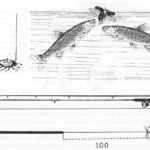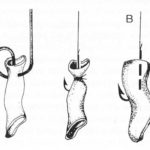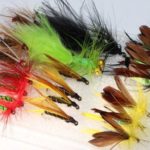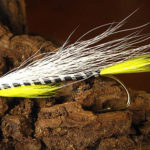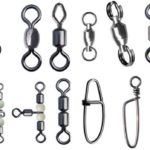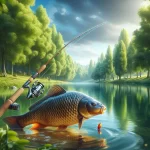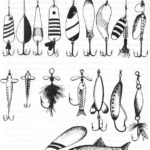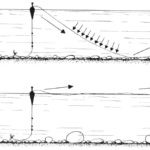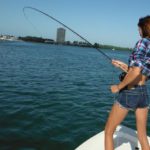Połów Klenia na spinning i przepływanką.
Zasady spinningowania.
Obowiązują tu ogólne zasady połowu spinningiem. Najmniejsze, a więc i najlżejsze przynęty (błystki lub martwe rybki o długości do 4-5 cm) wymagają bardzo lekkiego wędziska o dość miękkiej szczytówce i półmiękkiej akcji, obciążalności 10-15 g, lekkiego kołowrotka o płytkiej szpuli i możliwie cienkich miękkich żyłek (0,15-0,18 do 0,20 mm). Typy błystek i ich kolorystyka powinny być zgodne z ogólnymi zasadami; szczególnie trzeba podkreślić skuteczność błystek matowosrebrnych i perłowych oraz celowość urozmaicania osi błystek obrotowych czerwonym detalem (koralik na osi, nitka itp. na haczyku). Pomocne mogą się okazać tu kombinacje małej plastikowej rybki i błystki obrotowej (Mepps nr 1 -2).
Łowiąc spinningiem musimy do powolnej reakcji klenia (szybkość reakcji jest w pewien sposób zależna od warunków cieplnych), dopasować odpowiednio tempo prowadzenia przynęty, nie może ono być jednak zbyt wolne – nie należy pozwalać kleniowi bawić się przynętą.
Spinningowanie ma też, niestety, złą stronę: bywa najczęstszą przyczyną „wyszkolenia” klenia. W wodach dziewiczych możemy spinningować z powodzeniem w każdych warunkach, w wodach bardzo licznie odwiedzanych przez wędkarzy tylko wyjątkowo, np. na początku sezonu, do połowy lata, wieczorem po zachodzie słońca; o szarówce tylko w spokojniejszych wodach i na granicy bystrzyn i spokojnych odcinków. W wodach stojących możemy odnosić sukcesy tylko w lecie przy tzw. biologicznym zmętnieniu. W końcu lata i jesienią, kiedy woda jest zupełnie przezroczysta, spinningiem wiele nie zdziałamy. Oczywiście, nie trzeba w związku z tym wykluczać możliwości, że poskutkuje jakiś nowy, nie stosowany w danej wodzie typ przynęty.
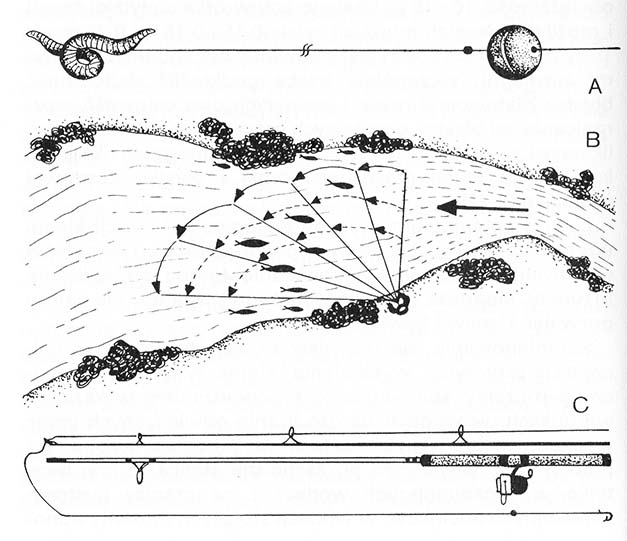 W wodach o łagodnym prądzie skuteczny może być połów przepływanką: A —szczegóły uzbrojenia wędki z okrągłym ciężarkiem, B — na takich stanowiskach poszukujemy klenia, C — przygotowana wędka.
W wodach o łagodnym prądzie skuteczny może być połów przepływanką: A —szczegóły uzbrojenia wędki z okrągłym ciężarkiem, B — na takich stanowiskach poszukujemy klenia, C — przygotowana wędka.
Zasady połowu przepływanką.
Przy tej metodzie potrzebne nam jest lekkie wędzisko o półmiękkiej akcji, długości nawet 4—5 m i obciążalności 10-20 g, mały lekki kołowrotek o stałej szpuli (ewentualnie zwykły o szpuli ruchomej), żyłka 0,15-0,18 mm. Przepływanką możemy łowić na powierzchni albo na różnych głębokościach. Branie ryby rejestrujemy za pomocą palca, którym przytrzymujemy żyłkę, a więc spławik – jeśli w ogóle jest potrzebny – ma za zadanie tylko utrzymanie przynęty na odpowiednim poziomie wody. Wybieramy raczej spławiki z naturalnych materiałów – z nie barwionego korka, gęsiego pióra itp.
Wielkość haczyka dopasowujemy do przynęty – czerwony robak nadaje się na haczyk nr 6-8, larwy na numery 10-12, chrabąszcza i konika polnego nakłuwamy na haczyki wielkości 3-4. Wybór przynęty uzależniamy od sezonu, a także od sposobu łowienia – giez, konik polny, chrabąszcz nadają się do połowu przede wszystkim na powierzchni; owoce, dżdżownice można stosować w różnych warstwach wody, także na dnie. Do połowu na przynętę toczoną po dnie nadają się zwłaszcza okrągłe owoce — czereśnie, wiśnie, śliwki, truskawki. Kleń nie ma zwyczaju przebywać w wodach głębszych niż 2 m, a więc lekki spławik o wyporności 3-4 g montujemy z reguły na stałe w dwóch punktach. Dzięki temu podczas połowu z prądem możemy stosować przepływankę z przytrzymywaniem spławika i osiągnąć w ten sposób maksymalny kontakt z przynętą pozwalający odpowiednio wcześnie reagować na branie. Ciężarek przelotowy umacniamy ogranicznikiem z gumki wentylowej w odległości 50-60 cm, żeby ryby niepotrzebnie nie straszyć. Jeśli prąd wody jest silny, odległość tę skracamy.
Kiedy zdobędziemy już odpowiednią zręczność spróbujmy stopniowo zwiększać promień połowu dbając przy tym, by nie zwisał nadmiar żyłki i żeby spławik tylko towarzyszył przynęcie, a w żadnym wypadku nie wyprzedzał jej. Kiedy już zasłużymy na miano mistrzów i będzie nam się udawało utrzymać bliski kontakt z przynętą nawet na odległość 15-20 m, naszą zdobyczą staną się największe, najostrożniejsze egzemplarze.
